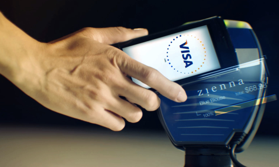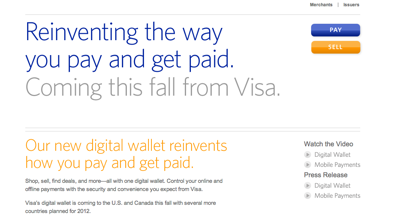It’s no secret that credit card companies are shelling out big bucks and aggressively forming partnerships and deals to start cashing in on the mobile and digital payments innovations currently taking place. American Express, which recently debuted its own digital payments product Serve, has been particularly aggressive on the partnerships front, striking recent deals with both Foursquare and Facebook. Mastercard has bet on NFC with a partnership with Google for Google Wallet and bought online payments gateway DataCash for $520 million last fall. And Visa has made a number of major moves in the mobile and digital payments space of late; including making an investment (and taking on an advisory role) in disruptive startup Square, buying virtual goods payments platform PlaySpan for $190 million, and acquiring mobile payments company Fundamo for $110 million. We sat down with Visa’s Global Head of Mobile Product Bill Gajda and the company’s Head of Global Product Strategy, Innovation and eCommerce Jennifer Schulz to discuss how the financial company is planning to compete in both mobile and digital payments.
MOBILE
Gajda explains that there are three prongs to Visa’s mobile payments strategy. One of these is NFC, and focuses on payments using a mobile phone at a physical store. For background, NFC (near field communications) enables people to make transactions, exchange digital content and connect electronic devices with a simple touch. As we’ve seen with Google Wallet, Android phones such as the Nexus S are being built with NFC chips, making your cell phone a mobile wallet. Visa recently joined the ISIS network, a NFC mobile payment network that is a joint venture formed by AT&T, T-Mobile and Verizon. ISIS will soon launch in a number of markets, including Utah and Texas.
Gajda explains that Visa is licensing mobile payments applications PayWave for integration with the ISIS wallet and the company is actively looking for other ways to integrate with NFC into the company’s mobile payments structure.
Of course, some aren’t so bullish on NFC, notably eBay (who owns PayPal) CEO John Donohoe, who in a recent earnings call said merchants refer NFC “not for commerce.” And odd statement considering PayPal just dipped its toes in the NFC pool with support for Android.
 Gajda tells is, “I think for some people NFC will replace the actual physical credit card but it will be a long time before NFC replaces all payments.” He believes that we are going to start seeing more traction by end of this year but says the capability of “taking credit cards and putting them on mobile phones will represent the long tail” in payments. But he adds, “the pieces are in place for NFC to take off.”
Gajda tells is, “I think for some people NFC will replace the actual physical credit card but it will be a long time before NFC replaces all payments.” He believes that we are going to start seeing more traction by end of this year but says the capability of “taking credit cards and putting them on mobile phones will represent the long tail” in payments. But he adds, “the pieces are in place for NFC to take off.”
The second part of the Visa’s mobile strategy involves the digital wallet and the mobile web. Gajda says that as e-commerce ramps up on mobile phones, there is a need for one-click, simple username and password checkout experience in a transaction being made on a mobile device. That’s an area where PayPal has been working hard to dominate in but Visa sees room for other players. Should we expect a PayPal-like, one-click mobile payments technology coming from Visa soon? Perhaps, the company hasn’t been afraid to enter PayPal’s territory in the past, launching a peer to peer payments service earlier this year.
In May, Visa announced its plans for the digital wallet. We’ll explain this initiative later in the post, but part of this platform would allow you to access your loyalty points, credit cards and more from your mobile phone at the point of sale. And the third pillar of Visa’s mobile strategy is incorporating value-added services like real-time alerts, contextual services, and offers at point of shopping based on where you are.
Visa actually tested a partnership with retailer The Gap earlier this year which alerted customers via SMS of discounts in stores near them. Gajda tells us Visa is working with a number of other retailers and banks on similar deals which will be announced soon.
Gajda says there are a number of other factors at play in the mobile payments place that need to be highlighted when talking about mobile payments. International is a huge growth area in mobile payments. He tells is that outside the U.S., there are a large number of people who have mobile phones but don’t have banking relationship or credit card. In fact, he says there are 2 billion people in world that have phone, but don’t have a bank account or credit card.
In these markets, Visa’s goal is to bring prepaid accounts, purchasing power and other financial services to basic phones. These could include topping up a mobile phone with airtime, buying transit tickets, peer to peer payments. And this goal was the mean reason behind the purchase of behind the $110 million purchase of Fundamo. The company’s platform delivers mobile financial services to unbanked and under-banked consumers around the world, including person-to-person payments, airtime top-up, bill payment and branchless banking services.
Connecting with the small business world that don’t yet use credit cards or are new to the system is another area where Visa feels there is strong potential, especially with mobile payments. That’s why the company invested in disruptive mobile payments company Square and took an advisory role in the company. Gajda says that the power of Square is that it is enabling small businesses and independent workers such as doctors, designer and other merchants to start using credit cards and grow their businesses. It would make sense for Square and Visa would somehow work to harness the power of their partnership (As of April roughly two-thirds of transactions using Square’s payments service were through Visa credit cards.), but it’s unclear what the two companies will reveal any new co-produced products soon.
Gajda tells us that the biggest challenge of mobile payments in the current market the massive amount of fragmentation in the mobile industry. He explains that with all of the various mobile operating systems, specific manufactured phones, applications and more, keeping up with pace of innovation on the development side is a major challenge for Visa.
But he says that there is still so much room for innovation around how we pay with mobile phones. “With the rise of smartphone usage, we are already seeing a lot of innovation around commerce,” he explains. “It’s inevitable that this will extend to the payments around the sales in mobile commerce.”
DIGITAL
Visa’s digital payments guru Schulz outlined her strategy for digital payments at the company, which centralizes around the creation of the digital wallet. Schulz says that because of the fact that e-commerce is being more easy and convenient with customers, especially with m-commerce, the underlying payments infrastructure has to evolve.
 And Visa’s answer to this is a new digital wallet initiative. Here’s how it works. Users will have an account, and they can add their credit card numbers (and cards from other credit card companies such as American Express and Mastercard). Visa is partnering with a number of financial institutions to offer this product to their customers.
And Visa’s answer to this is a new digital wallet initiative. Here’s how it works. Users will have an account, and they can add their credit card numbers (and cards from other credit card companies such as American Express and Mastercard). Visa is partnering with a number of financial institutions to offer this product to their customers.
Users can also load their loyalty points and rewards cards, as well as organize their shopping lists. Schulz describes it as a “wallet in the cloud.” But she says the key to the success of the wallet is a seamless, one-click payments experience for the consumers. So Visa has partnered with a number of large-scale retailers (which will be announced soon) to integrate what Schulz refers to as a ‘new acceptance mark’ on a merchant payments page.
So there will be a button you can click on, which will prompt you to sign-on and then will sync your digital wallet with the purchase in your shopping cart. So for example, imagine you had a camera in your cart, and Visa offered a 20 percent off at camera’s purchased at BestBuy, the wallet would sync and show the discount in your cart. The same works for loyalty points and more.
Schulz explains that the idea behind the wallet is that consumers want control over their wallet and want to have payment information and access available to them at all times. She believes that the digital wallet will click to buy incorporated on retailers’ sites is essential to the future of e-commerce in both the U.S. and emerging markets.
She compares the digital wallet offering to “two-hand clapping.” ” You can have a digital wallet,” Schulz explains, “but you need a merchant solution of click to buy, and Visa’s going to transform that experience.” And Schulz highlights another recent acquisition, Playspan, has helping drive a simplified commerce experience, a.k.a. click to buy, within game or within app.
Of course adding another checkout experience to online retailers’ sites can be a complicated and time-consuming process. But that’s where Visa’s $2 billion acquisition of CyberSource comes in. CyberSource is said to process about 25 percent of all e-commerce dollars transacted in the United States, and operates e-commerce for hundreds of thousands of retailers. Schulz says this relationship has helped speed up the pace of implementation.
Creating the digital wallet, both on the mobile and web platforms, is no easy task. Visa has a name for itself in the credit card industry but the fact is that the brand still has to attach innovation to itself in order for people to take these products seriously. Perhaps that’s one of the reasons why Google’s Mobile Wallet news created waves, even though NFC technology is in its early stages.
Visa competitor American Express is also working hard to innovate both at the large retailer level, as well as among smaller retailers, with GoSocial.
While Visa, American Express and others are looking to capitalize on the changes taking place in the payments industry, it is a challenging effort. Local commerce is a big part of this, and everyone is trying to find a way to close the redemption loop. But e-commerce, amongst larger retailers, is also a multi-billion dollar market that Visa hopes to continue to play in with products like a digital wallet. And in-store payments, whether that be through NFC, Square or others, represent another market.
I’ve been talking to a number of executives of payments companies and founders of innovative payments startups, and while their objectives are different, they all seem to agree on one thing. It’s early and there is still much more innovation were going to see in the next few years in the online and mobile payments space.
